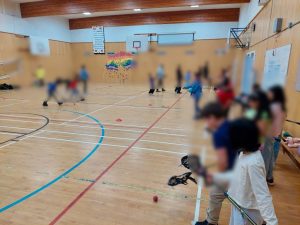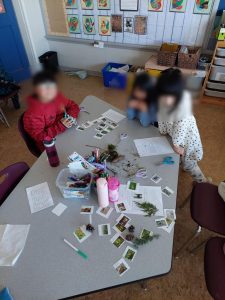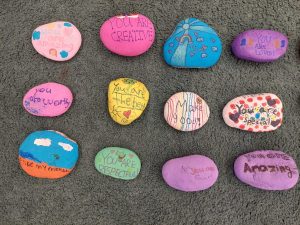Dear Division 11 Families,
Our skating sessions have officially come to an end, and it has been amazing to see how much confidence and skill the students have gained over the course of our trips. Thank you for your support in making these sessions such a success!
Thank you for parents who came today on Tuesday, as we resumed our Family Reading. We had materials ready for some of the math games that the students have been playing in class. What a fun time!
We are writers.
In writing, we’ve been focusing on making our stories more engaging for readers. The students have been using creative similes and are learning to think like writers by pausing to consider ways to add more details to their work. See the chart (This will continue to grow.) that we use at the start of our lessons to help set writing goals.

We also read the book If I Built a School by Chris Van Dusen. Students were very creative! They learned about nouns and adjectives that describe nouns.
Ways to support at home or try this during your car ride: Name different nouns and challenge your child to come up with interesting adjectives. Be playful with your words and have fun together! Then it’s your turn! Ask your child to give you a noun for you to come up with interesting adjectives. Have fun!
For example: cat (noun) and here are some adjectives to describe the noun:
- Color: fluffy, striped, golden
- Size: tiny, enormous, chubby
- Personality: curious, playful, sneaky
We are mathematicians.
In math, we have been continuing our learning on rounding. We want our students to understand why we round down with 0, 1, 2, 3, and 4, and round up with 5, 6, 7, 8, and 9. To help with this, we’ve been using number lines to provide a visual understanding of the concept. Now, many students have progressed beyond the number line and are able to round numbers quickly and accurately in their heads.
We continued to practice our math fact fluency by learning about working with a 10.
Ways to support at home: Continue to practice all of the strategies taught so far.

A simple way to practice at home is to create a random numbers chart.

Hannukah
On Friday, we had the greatest privilege and blessing to have Juliette’s mom, Anna, come into our class to teach us about Hannukah, the Jewish Festival of Lights with Juliette. They told us about the miracle of the oil that lasted eight nights when it only had enough to last one. The menorah (special candle holder) was lit which illuminated our classroom. We learned about what each one represents. Students were given an opportunity to play with the dreidel. Anna and Juliette also surprised us with delicious latkes (potato pancakes) served with apple sauce! They were scrumptious!
Thank you so very much, Anna and Juliette, for sharing with us. We are grateful for your time and hard work!


Art
 Our students have also been working on creating 3D snowflakes. Although there were many steps involved, they picked up the process quickly and created some beautiful finished pieces.
Our students have also been working on creating 3D snowflakes. Although there were many steps involved, they picked up the process quickly and created some beautiful finished pieces.
On Friday, we met up with our little buddies! Thank you to the hard work and dedication of Ms. Pasqualetto, the Kindergarten teacher, children were given 5 cookies to decorate. They did a great job of making sure their little buddies received help if they needed it.
Learning Updates (aka Report Cards)
Your child’s Learning Update will be available on Wednesday, December 18. You should have access to login to MyEducation BC to access it. If you cannot, then you can request for a password reset by clicking HERE. Should you have any questions or would like to meet with us, please let us know.
We are incredibly proud of all the learning your child has demonstrated since the beginning of the school year. We hope that you enjoyed listening to your child teach you about patterns, place value, matter, and the transfer of thermal energy last week when they brought home their learning. They practiced by pretending to be each other’s parent and had fun doing it!
Feel free to scroll through the 14 weekly blog posts since we started our journey together at the beginning of September. We commend each child (and you) for your contribution to our cohesive and caring community. These blog posts are a great way to connect with your child about what they are learning in class. When I asked them how many have seen them, not many said they did. These posts are written for you both to share in their learning so feel free to have them read it as practice for reading. When students can tell you what they are learning about, they have to remember and explain; this exercise helps them solidify their learning.
Pancake Breakfast
This Thursday, it is pajama day! Your child doesn’t have to change in the morning and is welcome to come to school in the same clothes! Our pancake breakfast time with our little Kindergarten buddies is at 9:05 AM. Please be on time so that our class can go to the gym on time.
Snacks
Your children are growing!! We are noticing a number of students going to the office asking for snacks. They are saying that they finish their snacks but are still hungry. In January, please have your child bring extra snacks. Thank you!
Sing-a-long
On Thursday at 1 PM, there will be a sing-a-long for odd divisions. The Intermediate Choir will also perform. You are welcome to join us in the gym at this time!
Friday Party
On Friday afternoon, we will be having a class party. Children are encouraged to bring a board or card game from home to teach and share with their classmates. It’s a great way to introduce a fun game to others so that they may buy it to play at home too! It’s also a phenomenal way to practice their verbal communication skills as they try to teach others how the game is played.
If your child would like to bring a treat to share (nothing with nuts, please), they are welcome to as well! Thank you so much for your contribution!
In case we don’t get a chance to see you, we wish you and your family a wonderful winter break. Enjoy this extra time with family and friends. Thank you for reading these blog posts each week and for your continued support. We appreciate you! We love your children and care deeply for them. What a joy and blessing to be their teachers!
With grateful hearts, Ms. Kim and Ms. Chan





 Vancouver Warriors
Vancouver Warriors











 How I Met My Monster Read-Aloud:
How I Met My Monster Read-Aloud:






